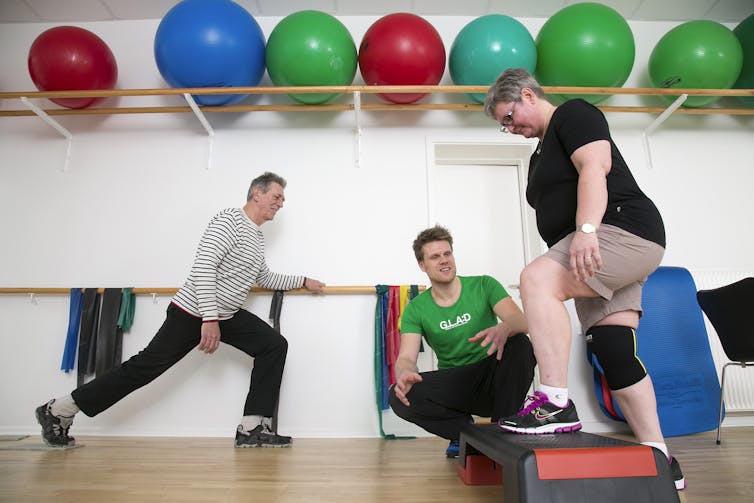If your knee hurts, keep exercising, says expert
By Ewa M Roos, University of Southern Denmark
If you take up exercise later in life, as a treatment for joint or hip pain, you should expect a small, temporary increase in pain. But if you proceed sensibly, you will be rewarded with pain relief similar to that of a non-steroidal anti-inflammatory drug, such as ibuprofen, and twice that of a non-prescription painkiller, such as paracetamol. In fact, the pain relief from taking up exercise is large enough that many people put their knee or hip surgery on hold.
Physical activity is important for good health and is prescribed by doctors to treat a range of diseases, including diabetes and cardiovascular disease. But many people don’t follow this advice because of aching joints and the fear that exercise may harm these joints.
Paradoxically, the last 20 years of research has found that exercise is a good pain reliever. Today, exercise is recommended worldwide as a treatment for painful joints in middle-aged and older people. However, recommending is one thing. Putting this recommendation into practice is something else altogether.
Widget not in any sidebars
Most people experience a 10% pain increase when they start to exercise – some experience more, others less. This is not a warning sign but the body signalling that you are doing something you are not used to. Our bodies, including bone, muscle and cartilage are great at adapting and their quality improves when we exercise.
How much pain relief you will get depends on how much exercise you do. In our study of 10,000 people with knee and hip osteoarthritis, we found that people who exercised twice a week for six weeks experienced 25% pain relief, on average.
Earlier research also shows that people who exercise in groups, supervised by a physiotherapist, experience greater pain relief than those who exercise at home, unsupervised. Reasons for this difference may be that we work harder and dare to do more when guided by a physiotherapist with specialist knowledge.
To get the most from exercise, you should feel short of breath, or sweat a little, and increase the level of difficulty of the exercises as your body gets stronger.

Author provided
Two simple rules
You can exercise safely by following two simple pain rules. One, the pain you experience after exercise should be at a level that is tolerable. And, two, you shouldn’t experience any increase in pain from day to day.
Pain should be assessed daily after exercise on a zero-to-ten scale. On this scale, zero to two is considered “safe”, two to five “acceptable”, and five to ten “avoid”.
Let’s say your usual pain is three, and after exercising you rate it five. That’s fine. If your usual pain is three and after exercising you rate it a seven, you have done too much and should cut back the next time.
If your pain goes up to five after exercising, but the next morning is back at three – your usual morning pain – that’s fine. If your pain goes up to five after exercising, and is still at four or five the next morning (that is, more than your usual morning pain), you have done too much and should cut back. Keep at it, but at a lower level.
Exercising with arthritis
Interestingly, our research shows that it is safe to exercise with severe arthritis. When people with severe or bone-on-bone arthritis followed these two simple pain rules, 95% of all exercise sessions were performed with acceptable pain, and pain was relieved after a few weeks.
In a recent study, we enrolled people with mostly severe arthritis who fulfilled all the criteria to have a knee replacement op. All the participants received information on arthritis and its treatments, including self-help advice. They also took part in supervised exercise sessions twice weekly for eight weeks, and saw a dietitian if they were overweight.
Half of the participants were randomised to have their knee replaced. Among those not having their joint replaced immediately, only a quarter chose to have their joint replaced within a year. In other words, the pain relief that people experienced as a result of the exercise was enough for three-quarters of the participants to delay surgery for at least a year.
![]() Exercise, especially when supervised, provides effective pain relief, but requires physical effort and sweat. Passive treatments, such as manual therapy, deep tissue massage and muscle stretches, given by a physiotherapist, doesn’t seem to work for people with hip or knee pain.
Exercise, especially when supervised, provides effective pain relief, but requires physical effort and sweat. Passive treatments, such as manual therapy, deep tissue massage and muscle stretches, given by a physiotherapist, doesn’t seem to work for people with hip or knee pain.
Ewa M Roos, Professor of Muscle and Joint Health, University of Southern Denmark
This article was originally published on The Conversation. Read the original article.




